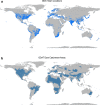Global Dam Tracker: A database of more than 35,000 dams with location, catchment, and attribute information
- PMID: 36823207
- PMCID: PMC9950439
- DOI: 10.1038/s41597-023-02008-2
Global Dam Tracker: A database of more than 35,000 dams with location, catchment, and attribute information
Abstract
We present one of the most comprehensive geo-referenced global dam databases to date. The Global Dam Tracker (GDAT) contains 35,000 dams with cross-validated geo-coordinates, satellite-derived catchment areas, and detailed attribute information. Combining GDAT with fine-scaled satellite data spanning three decades, we demonstrate how GDAT improves upon existing databases to enable the inter-temporal analysis of the costs and benefits of dam construction on a global scale. Our findings show that over the past three decades, dams have contributed to a dramatic increase in global surface water coverage, especially in developing countries in Asia and South America. This is an important step toward a more systematic understanding of the worldwide impact of dams on local communities. By filling in the data gap, GDAT would help inform a more sustainable and equitable approach to energy access and economic development.
© 2023. The Author(s).
Conflict of interest statement
The authors declare no competing interests.
Figures





















References
-
- IEA. Renewables 2020. Tech. Rep., IEA (2020).
-
- IEA. Electricity Information: Overview. Tech. Rep., IEA (2021).
-
- Gernaat DEHJ, Bogaart PW, van Vuuren DP, Biemans H, Niessink R. High-resolution assessment of global technical and economic hydropower potential. Nature Energy. 2017;2:821–828. doi: 10.1038/s41560-017-0006-y. - DOI
-
- Zarfl C, Lumsdon AE, Berlekamp J, Tydecks L, Tockner K. A global boom in hydropower dam construction. Aquat. Sci. 2015;77:161–170. doi: 10.1007/s00027-014-0377-0. - DOI
-
- Couto TBA, Olden JD. Global proliferation of small hydropower plants - science and policy. Front. Ecol. Environ. 2018;16:91–100. doi: 10.1002/fee.1746. - DOI
Publication types
LinkOut - more resources
Full Text Sources
Miscellaneous

